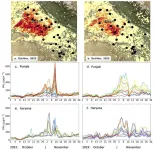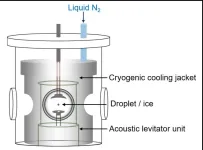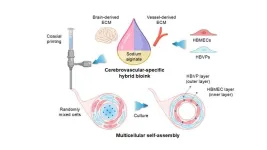(Press-News.org) Preventing the cell’s protein factories from making the notorious cancer-causing protein MYC could stop out-of-control tumors.
For decades, scientists have tried to stop cancer by disabling the mutated proteins that are found in tumors. But many cancers manage to overcome this and continue growing.
Now, UCSF scientists think they can throw a wrench into the fabrication of a key growth-related protein, MYC, that escalates wildly in 70% of all cancers. Unlike some other targets of cancer therapies, MYC can be dangerous simply due to its abundance.
In a paper that appears Feb. 4 in Nature Cell Biology, researchers at UC San Francisco describe how to curb MYC levels. They discovered that another protein, called RBM42, makes cells churn out MYC.
Disrupting RBM42 in pancreatic cancer cells, one of the deadliest cancers, stopped them from growing. The researchers now think drugs could be developed to do the same in a host of other fast-growing cancers that are driven by MYC. By blocking RBM42, such drugs would effectively block MYC.
“MYC is what we see when a cancer is resilient to anything we try to do to defeat them,” said Davide Ruggero, PhD, a professor of urology at UCSF and senior author of the paper. “Now that we can see the machinery that controls the amount of MYC, there may finally be a way to stop it.”
Why so much MYC?
MYC was first identified in the 1970s by UCSF Nobel Laureates Michael Bishop, MD, and Harold Varmus, MD. They found MYC while studying cancers that are caused by viruses. MYC was a normal protein that only took on a malevolent role in cancer. The discovery revolutionized cancer research and cancer care.
Unlike other cancer-causing factors, though, cancerous MYC isn’t always mutated. Cells produce MYC unceasingly to become cancerous without a mutation in the MYC gene directly. And pathologists use it as a microscopic marker for fast-growing cancers.
“Everyone knows how important MYC is for cancer, but there are no drugs to block it,” said Joanna Kovalski, PhD, first author of the paper. “So, we instead looked toward how MYC is actually made.”
Kovalski used a method called CRISPRi to hunt for factors that influence how much MYC was produced in cancer cells. Surprisingly, the experiment pointed to an obscure protein known as RBM42, which has not attracted much attention until now.
Poring over genomic data from pancreatic cancer patients, Kovalski found abundant RBM42 in cells with lots of MYC. And the more RBM42 and MYC patients had, the worse they did.
Hijacking the protein assembly line
Kovalski and Ruggero wanted to know how RBM42 influenced the production of MYC.
Like any protein, MYC is built using the instructions that are stored in the MYC gene. First, in a process called transcription, the cell uses these instructions to make a blueprint, called mRNA. Then, in a process called translation, the cell’s protein factories, called ribosomes, use this mRNA to make MYC protein.
The scientists were surprised by what they found. When they disrupted RBM42, the cancer cells still produced MYC mRNA but stopped producing the MYC protein. This suggested that RBM42 was only involved in the second part of the process: the translation of mRNA into protein.
Further experiments showed why. RBM42 reshaped the MYC mRNA blueprint to make it better for processing by ribosomes. It also directed these mRNAs to the ribosomes – which churned out copious amounts of MYC. RBM42 ensured that MYC received preferential treatment from the cell’s protein factories.
“Proteins like RBM42 and MYC exist in every cell but are normally restrained,” Ruggero said. “During cancer, we saw that RBM42 behaved quite differently, hijacking the ribosomes to work with these specific mRNAs and do the cancer’s bidding.”
Drop the MYC
The researchers tried interfering with RBM42 in cancer cells in petri dishes, and then in mice. In both cases, when they removed RBM42, the ribosomes stopped making MYC, and the pancreatic tumors stopped growing.
“RBM42 really seems to be the Achilles’ heel for some of the worst cancers,” Ruggero said.
Kovalski, Ruggero, and their UCSF colleagues believe small molecules could intervene in this process like molecular wrenches jamming cancer's gears.
“Translation control deserves to be front and center in our efforts to treat cancer,” Kovalski said. “We now have great footing to interfere with the fastest-growing cancers and make a difference for patients.”
Authors: Other UCSF authors include Goksu Sarioglu, Vishvak Subramanyam, Grace Hernandez, Gilles Rademaker, PhD, Juan A. Oses-Prieto, PhD, MA, Macey Slota, Nimmy Mohan, PhD, Kaylee Yiakis, Isabelle Liu, Kwun Wah Wen, MD, PhD, Grace E. Kim, MD, Sohit Miglani, Alma L. Burlingame, PhD, Hani Goodarzi, PhD, and Rushika M. Perera, PhD.
Funding: This research was supported in part by the National Institutes of Health (1S10OD028511-01, P30CA082103, R01CA240603, R35CA242986), the National Sciences Foundation (NSF2034836), the American Cancer Society (133966‐PF‐20‐009‐01‐RMC, American Cancer Society Research Professor Award), and the Arc Institute. For all funding see the paper.
Disclosures: Ruggero is a shareholder of eFFECTOR Therapeutics, Inc. and is a member of its scientific advisory board. The other authors declare no competing interests.
About UCSF: The University of California, San Francisco (UCSF) is exclusively focused on the health sciences and is dedicated to promoting health worldwide through advanced biomedical research, graduate-level education in the life sciences and health professions, and excellence in patient care. UCSF Health, which serves as UCSF's primary academic medical center, includes top-ranked specialty hospitals and other clinical programs, and has affiliations throughout the Bay Area. UCSF School of Medicine also has a regional campus in Fresno. Learn more at ucsf.edu, or see our Fact Sheet.
###
Follow UCSF
ucsf.edu | Facebook.com/ucsf | YouTube.com/ucsf
END
Scientists want to throw a wrench in the gears of cancer’s growth
2025-02-04
ELSE PRESS RELEASES FROM THIS DATE:
WSU researcher pioneers new study model with clues to anti-aging
2025-02-04
SPOKANE, Wash. — Washington State University scientists have created genetically-engineered mice that could help accelerate anti-aging research.
Globally, scientists are working to unlock the secrets of extending human lifespan at the cellular level, where aging occurs gradually due to the shortening of telomeres–the protective caps at the ends of chromosomes that function like shoelace tips to prevent unraveling. As telomeres shorten over time, cells lose their ability to divide for healthy ...
EU awards €5 grant to 18 international researchers in critical raw materials, the “21st century's gold”
2025-02-04
The new EU-funded consortium “ForMovFluid” will study how fluids transformed the materials inside the Earth's crust. Thanks to the Marie Skłodowska-Curie Action Doctoral Networks programme, ForMovFluid will fund the doctoral studies of 18 researchers, and train them to become elite experts in the field of geoscience.
Moreover, this project will allow us to understand the origin of the so-called critical raw materials, of vital importance for the energy transition. Over a period of four years, ForMovFluid “Marie Curie” researchers ...
FRONTIERS launches dedicated call for early-career science journalists
2025-02-04
FRONTIERS announces a new call for applications for its Science Journalism in Residency Programme, funded by the European Research Council (ERC). This
third call is exclusively aimed at early-career journalists and will remain open until May 6, 2025, at 17h00 CEST.
Science journalists with up to five years of experience are invited to apply for a residency at a research institution of their choice, in an EU Member State or a
country associated with the EU’s Horizon Europe Programme. The residencies, lasting between three to five months, should focus on frontier science topics, in
collaboration with scientists.
The ...
Why do plants transport energy so efficiently and quickly?
2025-02-04
The efficient conversion of solar energy into storable forms of chemical energy is the dream of many engineers. Nature found a perfect solution to this problem billions of years ago. The new study shows that quantum mechanics is not just for physicists but also plays a key role in biology.
Photosynthetic organisms such as green plants use quantum mechanical processes to harness the energy of the sun, as Prof. Jürgen Hauer explains: “When light is absorbed in a leaf, for example, the electronic excitation energy is distributed over several states ...
AI boosts employee work experiences
2025-02-04
A new paper in the Quarterly Journal of Economics, published by Oxford University Press, shows customer service workers using artificial intelligence assistance become more productive and work faster. The effects vary significantly, however. Less experienced and lower-skilled employees improve both the speed and quality of their work, while the most experienced and highest-skilled workers see small gains in speed and small declines in quality. The researchers also found that AI assistance can help worker learning and improve English fluency, particularly for international workers.
Computers and software have transformed the economy with their ability to perform certain tasks with far ...
Neurogenetics leader decodes trauma's imprint on the brain through groundbreaking PTSD research
2025-02-04
BELMONT, Massachusetts, USA, 4 February 2025 - In a comprehensive Genomic Press Interview, Dr. Kerry Ressler, Chief Scientific Officer at McLean Hospital and Professor of Psychiatry at Harvard Medical School, unveils groundbreaking advances in understanding the neurobiological basis of post-traumatic stress disorder (PTSD) and related anxiety conditions.
Dr. Ressler's research bridges the gap between molecular neuroscience and clinical psychiatry, focusing on how the amygdala processes fear and trauma at cellular and genomic levels. "Most proximally, I hope that our work may lead to novel approaches to fear- and trauma-related disorders, perhaps even to prevent ...
High PM2.5 levels in Delhi-NCR largely independent of Punjab-Haryana crop fires
2025-02-04
International collaborative research led by Aakash Project* researchers at the Research Institute for Humanity and Nature (RIHN) show an unequivocal contribution of crop residue burning (CRB) to air pollution in the rural/semi-urban regions of Punjab and Haryana, and a relatively lower contribution than previously thought to the Delhi national capital region (NCR). We have installed 30 units of compact and useful PM2.5** in situ instrument with gas sensors (CUPI-Gs) and have continuously recorded air pollutants in 2022 and 2023. New analytical methods have been developed to assess ...
Discovery of water droplet freezing steps bridges atmospheric science, climate solutions
2025-02-04
A groundbreaking University of Hawaiʻi at Mānoa study on the freezing of water droplets suspended in air sheds light on a key process in Earth’s water cycle: the transformation of supercooled water into ice.
Conducted using a novel cryogenically cooled ultrasonic levitation chamber, the research captures real-time molecular-level changes during the freezing process, mimicking conditions in the Earth’s atmosphere. This innovative setup enables researchers to observe how water droplets transition to ice at subzero temperatures, providing ...
Positive emotions plus deep sleep equals longer-lasting perceptual memories
2025-02-04
Researchers at the RIKEN Center for Brain Science (CBS) have uncovered how perceptual memories linked to positive emotions, such as joy or happiness, are strengthened during sleep. The study, published in the scientific journal Neuron, could help scientists understand the neurological basis for overcoming conditions like drug or sexual addiction.
Why do emotional events, whether positive or negative, create strong, long-lasting memories of external information such as music, scene smells and textures received at the events? We know that sleep is essential for memory consolidation, the process that turns new events into memories, but do not ...
Self-assembling cerebral blood vessels: A breakthrough in Alzheimer’s treatment
2025-02-04
A 3D model accurately mimicking the Blood-Brain Barrier (BBB) in a laboratory environment has been successfully developed by research teams led by Professor Jinah Jang from the Departments of Mechanical Engineering, Life Sciences, IT Convergence Engineering, and the Graduate School of Convergence at POSTECH, and Professor Sun Ha Paek from the Department of Neurosurgery at Seoul National University Hospital. This study was recently published in Biomaterials Research, an international academic journal on materials science.
Neurodegenerative diseases, ...





